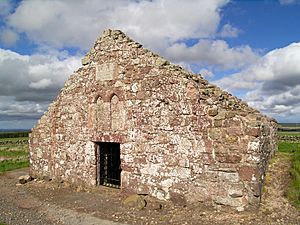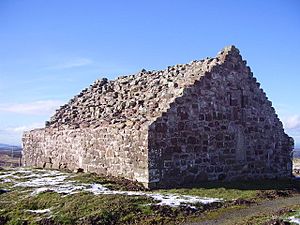Soutra Aisle facts for kids
Soutra Aisle is a very old building in the Scottish Borders. It's what's left of a much bigger place called the House of the Holy Trinity. This complex included a church, a hospital, and a friary (a home for monks). You can find it near the A68 road, about half a mile along the B6368.
Contents
A Look Back: Soutra's Early Days
The House of the Holy Trinity was started by King Malcolm IV in 1164. He gave it land to help it get going. The hospital was built near a main road called the Via Regia. This road was important for people traveling between the north and the Borders Abbeys.
Who Ran the Hospital?
The hospital was run by a group of monks called the Augustinian Order. They were known for their good works and helping others.
What Was the Hospital For?
Records from the 1400s tell us more about the hospital. It was mainly meant to be a place for poor people to find help. It wasn't just a religious building. The records also say the church was "built at the top of a hill". This spot was often windy and cold.
Changes Over Time: Soutra's Later Years
In the 1460s, something happened that caused the Crown (the king's government) to take away most of the land that supported the hospital. This land was then given to another hospital in Edinburgh.
How Soutra Aisle Survived
This made Soutra Aisle very poor. But it didn't completely disappear! It survived because the Pringle family started using it as their burial place in 1686. This meant the building was still cared for, even if the hospital part was struggling. Some sources say the hospital kept going until the mid-1600s.
Uncovering Secrets: What Archaeology Found
Scientists have done archaeological digs at Soutra Aisle. They found some amazing things that tell us about the old hospital.
Ancient Medicines and More
They discovered rare seeds from all over the world! These seeds were used for making medicines. They also found what might be medical waste, including over 200 teeth. This shows that the hospital was a busy place for healing.
Why So Little Remains?
The experts found very little of the hospital above ground. This is because its stones were taken away a long time ago. They were probably used to build other things.
How Many People Were There?
Dr. Brian Moffat, who led the digs, thought that the hospital was busiest between the mid-1100s and mid-1400s. He guessed that around 300 people might have lived there. These people would have helped visitors and patients.



